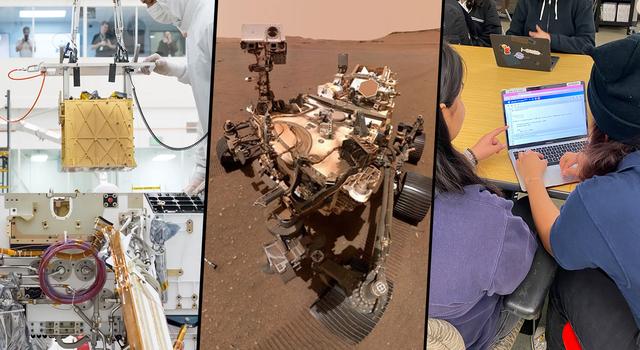Classroom Activity
Design an Alien
Overview
In this lesson, students will learn about the signs of life that scientists look for on other worlds. Next, they will imagine and draw their own alien that can survive with the traits and environmental conditions that come up when they roll a die.
Materials
Management
- Students can work in groups of two to four to create a single design together. Consider providing each group a different trait and environment from which to create their designs.
- For younger students in grades 2 and 3, you can opt to use only the environmental conditions.
Background
NASA explores our solar system to learn more about our neighboring planets and our home planet. One thing scientists are most interested in is whether Earth is the only location where life exists. Are we alone? If we are not, what does life look like on other planets?
Based on what we know about life on Earth, scientists have identified a set of environmental conditions they look for when determining whether another world could have conditions suitable for life, including (but not limited to):
- Water
- Energy
- Chemicals, including the common elements carbon, hydrogen, nitrogen, oxygen, phosphorus, and sulfur
- A stable environment that would allow life to form over time
Based on these factors, scientists believe that Europa – one of Jupiter's largest moons – may be suitable for life.

The puzzling, fascinating surface of Jupiter's icy moon Europa looms large in this reprocessed color view made from images taken by NASA's Galileo spacecraft in the late 1990s. Long, linear cracks and ridges crisscross the surface, interrupted by regions of disrupted terrain where the surface ice crust has been broken up and re-frozen into new patterns. Credit: NASA/JPL-Caltech | › Full image and caption
Slightly smaller in size than Earth's moon, Europa was discovered more than 400 years ago by astronomer Galileo Galilei and can be seen in the night sky using a small telescope. Recent observations of Europa by NASA spacecraft have revealed features that are especially interesting to scientists who are exploring the possibility of life beyond Earth.

Take a deep dive into Jupiter's moon Europa to learn more about its potential to support life. Credit: NASA/JPL-Caltech | + Expand image | › Full image and text description
Europa’s surface is made up of water-ice and is crisscrossed by long, linear fractures, cracks, ridges, and bands. Its icy shell is probably 10 to 15 miles (15 to 25 kilometers) thick. Scientists are almost certain that a large saltwater ocean exists beneath the ice. They estimate that the ocean is 40 to 100 miles (60 to 150 kilometers) deep. That's much deeper than any ocean on Earth. It also means that Europa could have about twice as much water as Earth. Similar to our planet, Europa is thought to contain a rocky mantle and iron core, so there is likely a seafloor under the ocean.
Scientists want to learn more about Europa because they suspect it has environmental conditions that could support life, including:
- Water and water-ice
- Energy from tidal heating or radiation from Jupiter
- Chemicals, including the common elements carbon, hydrogen, nitrogen, oxygen, phosphorus and sulfur
- An environment that has existed for billions of years
Even though Europa may have these potentially promising environmental conditions, it is also a very cold place that experiences high levels of life-damaging radiation from Jupiter.
But this same radiation that can harm life may also create fuel for life in a subsurface ocean. It does so by splitting surface water molecules into hydrogen and oxygen. Much of the hydrogen floats away, but the oxygen stays behind and might make its way to the ocean where it could react with other chemicals and provide chemical energy for microbial life.

Scientists study how radiation affects molecules on Europa's surface to determine the best place to search for biosignatures, or chemical signs that could imply the presence of life. Credit: NASA/JPL-Caltech | + Expand image | › Learn more
To learn more about whether Europa could support life, NASA is sending the Europa Clipper spacecraft to study the moon up close. The spacecraft will orbit Jupiter, flying by Europa close to 50 times, so that it can make scientific observations that will help us better understand the environmental conditions on and below the moon's icy surface. You can learn more about the mission and what it's designed to do on NASA's Europa Clipper mission website.
In this science talk, JPL planetary geologist Cynthia Phillips joins education specialist Brandon Rodriguez to discuss how future NASA missions will explore Jupiter's moon Europa and other ocean worlds.
Although Europa may seem to be a somewhat inhospitable environment to life as we know it, scientists have found organisms on Earth that live in similarly extreme conditions. Some of Earth’s extreme environments include harsh, dry, cold valleys of Antarctica; ocean depths with high pressures and no sunlight; and deep rock formations where organisms have no contact with organic material or sunlight from the surface. Organisms that live in extreme environments are known as extremophiles.
Where do we find extremophiles? We look for environments that push the limits for ordinary living organisms. NASA conducts analog testing in these extreme environments to better understand life on Earth and identify the potential for life in the universe.
In these extreme environments, scientists might look for evidence of life inside tiny samples of rocks, soil, water, or very old fossils, where it's not always easy to tell whether something is alive or not. So scientists look for these fundamental traits of life:
- Locomotion (walking, crawling, swimming, flying)
- Respiration (breathing, a metabolic process that involves chemical exchanges)
- Growth
- Reaction to stimuli
- Energy processing (eating, photosynthesis, etc.)
- Reproduction
Procedures
- Ask students what they know about Jupiter’s moon Europa. Explain that Europa is one of Jupiter’s largest moons and that scientists are especially interested in learning more about it.
- Show images of Europa, and have students discuss what they see. Why might scientists be interested in Europa? Accept all reasonable answers.
This interactive shows a real-time simulated view of Jupiter's moon Europa. Explore more by clicking and dragging or use the control icons. › Explore more with NASA's Eyes interactive.
- Share that it is possible that life could exist in Europa's ocean, in or on the ice shell that surrounds it, or on the land at the bottom of Europa’s ocean. There may even be lakes within the ice shell. NASA's Europa Clipper mission will study the moon from orbit to see if it has environmental conditions suitable for life. Explain that the spacecraft’s orbit will take it around Jupiter for repeated passes by Europa to conduct scientific observations.

This artistic representation (not to scale) of Europa in cross-section shows features and processes that might be found on the seafloor all the way up to the icy surface and above. The insets indicate potentially habitable sites such as hydrothermal vents as well as regions on and within the ice shell that could harbor biosignatures. | + Expand image
- Ask students to identify the environmental conditions needed for life on Earth. Scaffold as necessary and accept all reasonable answers, including those listed in the Background section. Would these be the same conditions needed for plant or animal life on another planet? What about on Europa?
- Ask students how they know if something is alive? Show students an image of a four-legged table and a four-legged animal. Ask them what the difference is between the two and to explain how they know one is alive and the other is not. Encourage them to think about things the animal does, such as breathing, moving, eating, etc.
- Show students an image of a plant or tree. Ask them how they know if a plant is alive. Encourage them to think about traits that can be observed over time (e.g., growth or taking up water) or on a microscopic level (e.g., photosynthesis or consuming carbon dioxide and producing oxygen).
- Ask students to identify the traits exhibited by life forms on Earth. Scaffold as necessary and accept all reasonable answers, including those listed in the Background section. Would these be the same characteristics needed for plant or animal life on another planet or Europa?
- Tell students they will be using their knowledge of environmental conditions and traits of life to design an alien (plant or animal) that could live on Europa. Their alien will need to survive in a specific environment and exhibit a trait determined by the roll of a die.
- Write on the board or display the following list of environmental conditions:
Europa Environmental Conditions
- Near a heat source
- In the salty ocean
- On the icy surface
- Inside the ice
- On the seafloor
- Your choice
- Have students roll the die, noting that the number they roll corresponds with the environmental condition where their plant or animal alien lives on Europa. Note: If students roll “Your choice,” they can select from any of the environmental conditions.
- Now, repeat the process with the following list of life traits, noting to students that the number they roll is the trait their alien needs to survive on Europa:
Life Traits
- Growth
- Locomotion / movement
- Respiration
- Reaction to stimuli
- Consuming resources
- Your choice
- Have students imagine what an alien plant or animal would look like to survive in the environment and with the traits they've rolled. Would an alien animal need to have feet, fins, or a radiation shield? Would an alien plant have a large trunk or huge leaves? Ask students to think about how they will illustrate various traits and then draw what they have imagined. Encourage students to use their knowledge of Europa and life and to be creative.
- Give students 20 minutes (or a limited amount of time) to draw their alien. Circulate and scaffold this process as needed. At the 10-minute mark, let students know they have ten minutes left. At the 15-minute mark, let them know they have five minutes left and to start wrapping up their drawings.
- Once their drawings are completed, have students write a paragraph explaining the environment in which their alien lives and the life trait it is exhibiting (or assign it as homework). Have them also name their alien, and share their alien design with classmates. Optionally, give them the choice to share a video of their drawing and explain the environment and life trait.
Discussion
- How does their drawing show the environmental conditions and traits for life?
- How does their alien design meet the unique challenges of the environment on Europa?
- Have students discuss how traits can be influenced by the environment and how environments can be influenced by traits, making a connection between the two. Encourage them to use evidence to support their claims.
Assessment
- Students should be able to describe their alien’s traits and how their design will help their alien live in Europa’s environment.
- Students should be able to provide evidence to support the claim that traits can be influenced by the environment and environments can be influenced by traits.
Extensions
- Roll the die to assign another life trait and environmental condition to the students’ aliens. Discuss how this change will affect the alien and its environment. Have students redesign the alien to reflect the new trait and environmental condition.
- Have students create a 3D model of their alien using craft supplies.
- Have students write in their science journals about their experiences designing an alien, describing the life traits and environmental conditions they were given.
Explore More
-
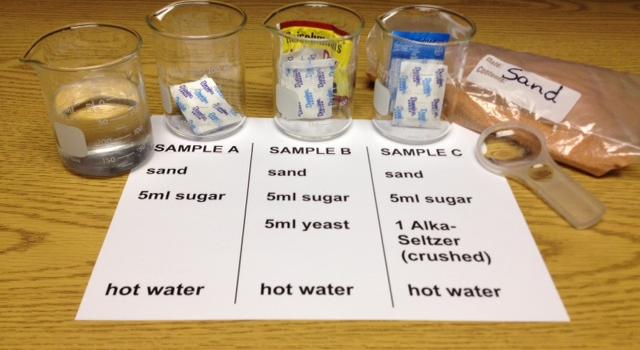 Lesson
LessonLooking for Life
Using the fundamental criteria for life, students examine simulated extraterrestrial soil samples for signs of life.
Subject Science
Grades 4-8
Time 30-60 mins
-
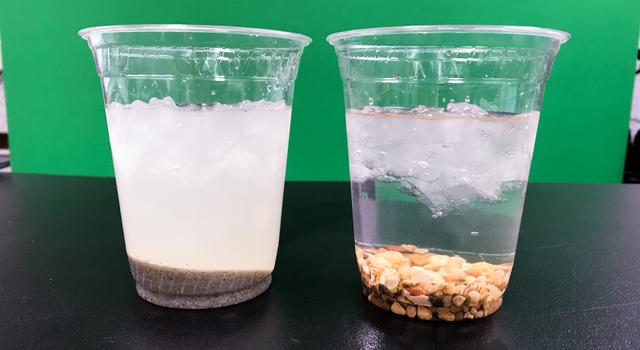 Collection
CollectionEuropa Lesson Collection
Explore a collection of standard-aligned lessons featuring the science and engineering behind NASA's Europa Clipper mission.
-
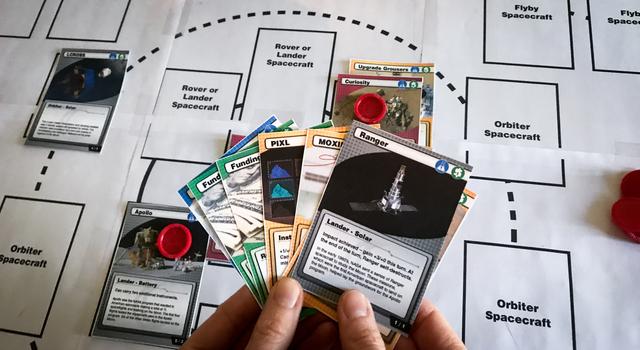 Student Project
Student ProjectNASA Space Voyagers: The Game
In this strategy card game, you'll build spacecraft that can explore the Moon, Mars, and other destinations throughout our solar system while withstanding challenges thrown your way.
-
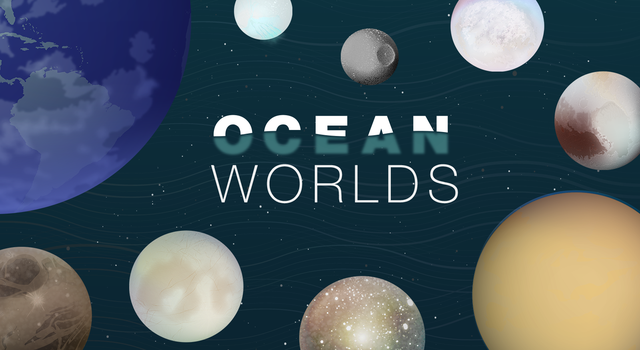 Slideshow
SlideshowOcean Worlds
Where might oceans – and living things – exist beyond Earth? Scientists have their eyes on these places in our own solar system.
-
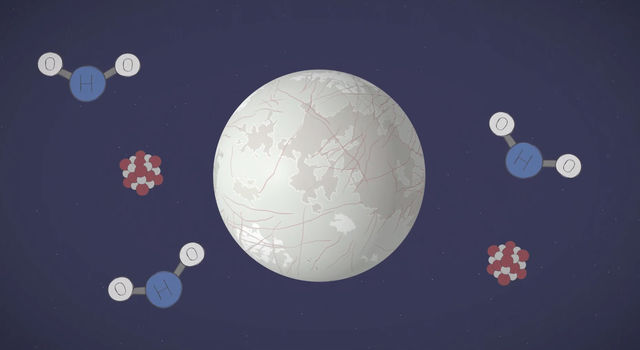 Video
VideoSpace Shorts: Could Jupiter's Moon Europa Have an Ocean?
Find out why scientists think Jupiter's moon Europa might have twice as much water as Earth!







